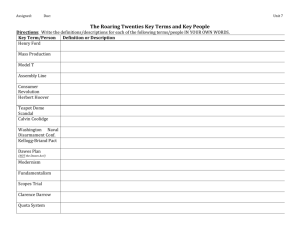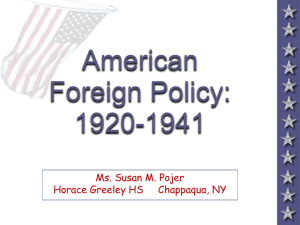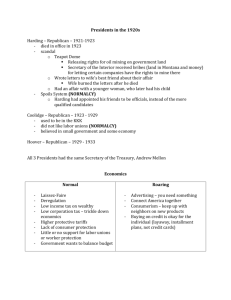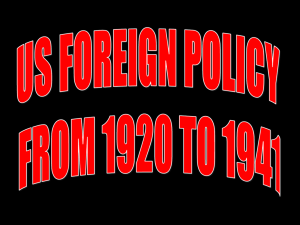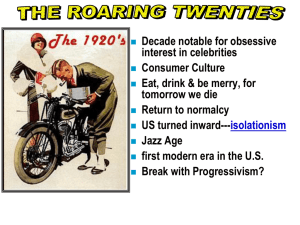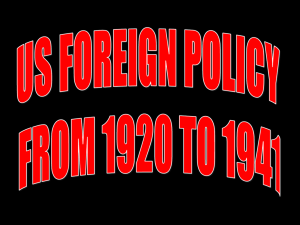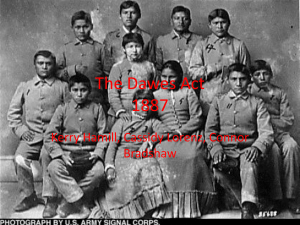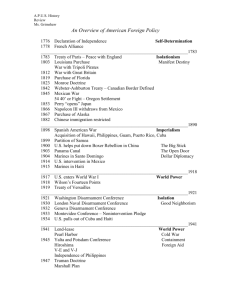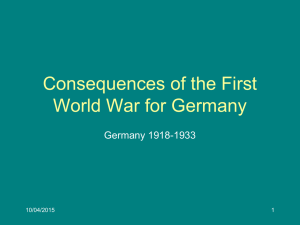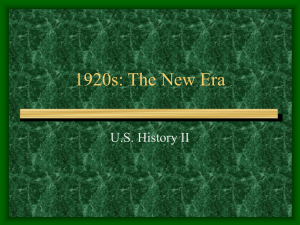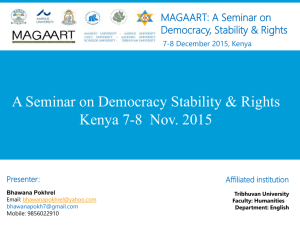US Foreign Policy 1919-1939
advertisement
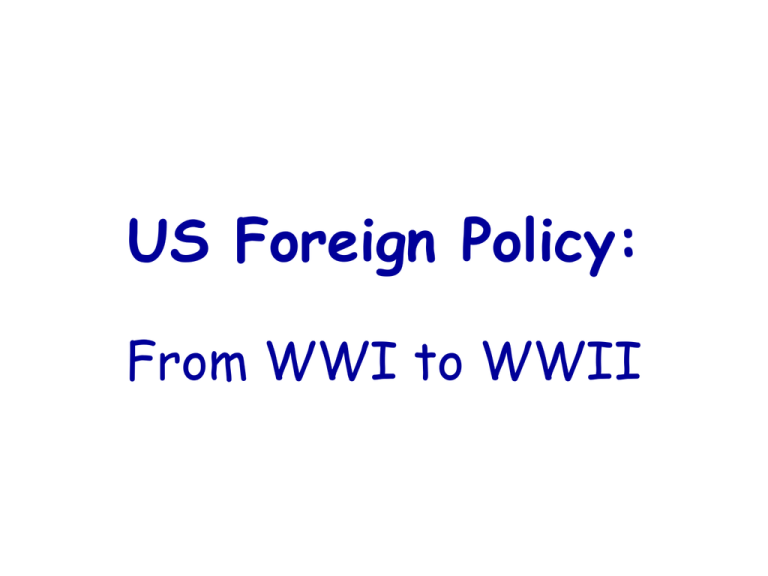
US Foreign Policy: From WWI to WWII Key Question: To what extent was the US “isolationist” between the two world wars? World War I: 1914-1918 - US policy of non-intervention in the first 3 years of the Great War - BUT, financial and material aid to European nations, especially US’ European allies - Merchant ships sunk + Zimmerman Telegram Official US entry, April 6, 1917 End of WWI and TofV - US President Wilson played a central role in developing the principles of postwar peace in the Treaty of Versailles: - moral concerns - economic concerns - political concerns Wilson’s “Moral Diplomacy” The U. S. should be the conscience of the world. Spread democracy. Promote peace. Condemn colonialism. “Wilsonianism” US foreign policies that: Pursue the spread of democracy Spread capitalism Promote internationalism US economic priorities • Maintain “Open Door” policy • In the 14 points: - Absolute freedom of navigation upon the seas (II) - The removal, so far as possible, of all economic barriers and the establishment of equality of trade conditions among all the nations consenting to the peace and associating themselves for its maintenance (III) Political plan for peace League of Nations: - internationalism - collective security - “to promote international cooperation and to achieve international peace and security.” US Senate rejection of Treaty of Versailles, 1919 Art. 10 “Members of the League undertake to respect and preserve as against external aggression the territorial integrity and existing political independence of all Members…. In the case of any such aggression… the Council shall advise upon the means by which this obligation shall be fulfilled.” Why? - League of Nations too interventionist - Problematic Article 10 - Party politics Military intervention in Russian Civil War, 1918-1920 - Polar Bear Expedition - 5,000 US troops - Am. Expeditionary Force Siberia - 8,000 US troops Washington Disarmament Conference, 1921-1922 Long-standing Anglo-Japanese alliance (1902) obligated Britain to aid Japan in the event of a Japanese war with the United States. Goals naval disarmament and the political situation in the Far East. Washington Naval Treaty, 1922 -US initiative for disarmament - Result was 5:5:3 ratio for US: Great Britain: Japan - Five-Power Treaty Five-Power Treaty, 1922 - A battleship ratio was achieved through this ratio: US Britain Japan France Italy 5 5 3 1.67 1.67 - Japan got a guarantee that the US and Britain would stop fortifying their Far East territories [including the Philippines]. - Loophole no restrictions on small warships Hyper-Inflation in Germany, 1923 Dawes Plan, 1924 - US banker Charles Dawes drew up a plan: 1. froze German reparations payments for 2 years 2. reduced level of repayments 3. provided loans to German industry Dawes Plan, 1924 Kellogg-Briand Pact, 1928 - 15 nations agreed to renounce the use of force for national objectives. - Eventually, over 62 nations signed. - Problem = no means of actual enforcement and gave Americans a false sense of security. Clark Memorandum, 1928 - Clark pledged that the US would not intervene in Latin American affairs in order to protect US property rights. Secretary of State J. Reuben Clark - This was a complete rebuke of the Roosevelt Corollary to the Monroe Doctrine! Young Plan, 1929 - By 1929 Germany not keeping up with Dawes Plan 2nd US initiative - Terms: 1. more US loans to Germany 2. reduced payments over 50 years - Negative response from Germany Young Plan, 1929 - For three generations, you’ll have to slave away! - $26,350,000,000 to be paid over a period of 58½ years. - By 1931, Hoover declared a debt moratorium. European Debts to the US US-French relations Tense post-WWI due to: - US pressure to repay war debts - 5 years between end of war and Dawes Plan (1924) - rejection of France’s proposals for military and economic cooperation Wall Street Crash, Oct. 1929 Late October 1929 Record 28.8 million shares changed hands at low prices Domestic economic chaos Worldwide economic crisis followed The Great Depression By 1932 25% of US workforce unemployed US increasingly preoccupied by domestic challenges Hoovervilles to The New Deal By 1932 25% of US workforce unemployed US increasingly preoccupied by domestic challenges Hoovervilles to The New Deal Smoot-Hawley Tariff Act International situation worsening 1930s Internationally Japan invaded China - Manchuria, 1931 - mainland China, 1937 Fascism on the rise in Europe - Nazi Germany’s expansion, 1936 - Mussolini’s invasion of Ethiopia, 1936 Italy and Germany openly interested in influence in South America US responses Monroe Doctrine remained US policy Stimson Doctrine, 1932 - Open-Door Policy Good Neighbor Policy, 1933 FDR’s “Good Neighbor Policy” 1933 policy toward Latin America Non-intervention & non-interference in domestic affairs Maintain & increase econ. opportunities Cultural evidence of: Disney goes Latin! Shoring up support for WWII Premiered in Rio de Janeiro August 1942 During WWII US responses, cont’d Neutrality Acts Ludlow Amendment FDR’s national addresses - The Fireside Chat US responses, cont’d Neutrality Acts Ludlow Amendment FDR’s national addresses - The Fireside Chat Pan-American Conference, 1938
